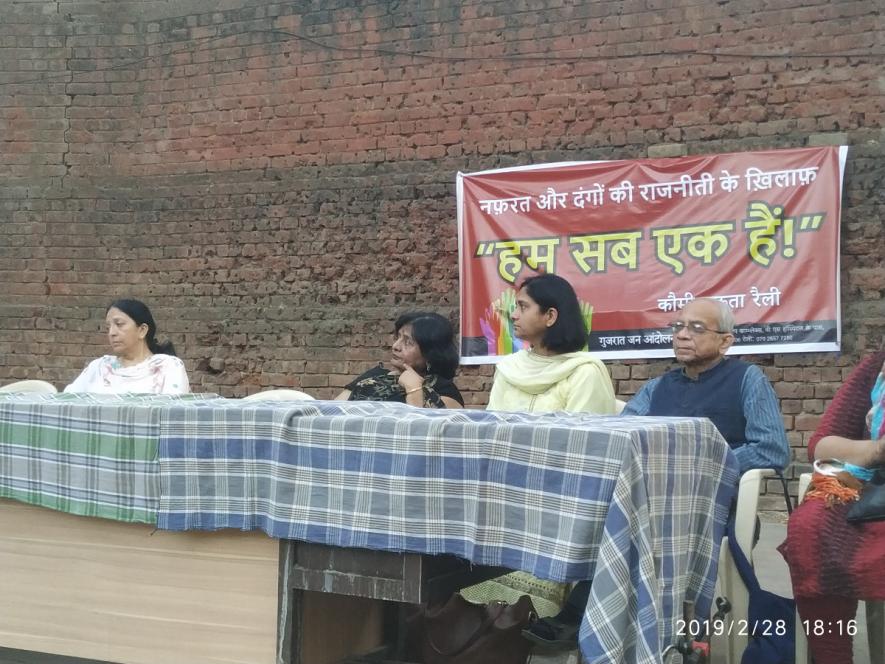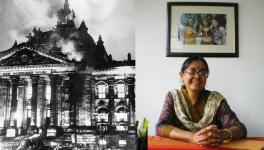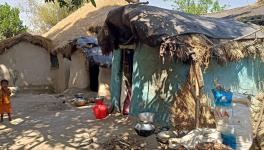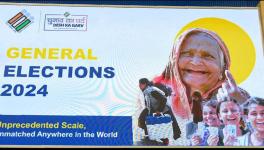17 years of Gujarat Riots - Memory of a Frenzied Mob and Legacy of Loss

Programme conducted by Jan Sangharsh Manch commemorating 17 years of Gujarat riots.
“Bheed, bheed, bheed … bheed hai samaj, samaj hai bheed, bheed hai vyakti, vyakti hai bheed.. hamare desh me bheed ki sanskriti bad rahi hai… (Mob, mob, mob, society is mob, mob is society, mob is a person, a person is mob, mob culture is increasing in our country.)”
As the lines of a street play by National Peace Group opened a programme to commemorate 17 years of the Gujarat riots, it brought back memories of the horror that the city had witnessed.
“The frenzied mob is back to haunt us again. This time they have taken away Akhlaq and 16-year-old Junaid (two victims of mob lynching),” said Huzefa, one of the actors and activist of National Peace Group as the play ended.
“Bheed se mera purana nata hai. (I have an old relation with this mob). In 1969, I was barely 4 years old, but I vividly recall running on railway tracks with my father who was 35 then, to save ourselves from a frenzied mob. My family lived in a refugee camp after the 1969 riots, till my father rebuilt his life and our home from scratch at the same place where he had lost everything. He had such faith in democracy and the secular fabric of our country,” said Nishrin Jafri, daughter of late Congress MP Ehsan Jafri who was killed in one of the mob violence episodes in Gulbarg society, Ahmedabad, in the 2002 riots in Gujarat.
See More: Gulbarg Society Still Weeps After 15 Years
“I have so many stories to tell. About the children I grew up with, my female friends, my neighbours—who were all lost to a frenzied mob in 2002. This is our home—where there are women whose husbands have been killed, women who witnessed their child being killed. There is Rupaben, who lost her son and has been searching for him for 17 years.” Nishrin said.
“In 17 years, some victims have died hoping for justice. More than 2,000 cases were registered post riots. In the initial years, the Gujarat government first delayed and then closed many cases through A, B, C summaries. Later, these cases were reopened after orders from the Supreme Court. The SC had identified 9 big cases out of those cases. These included Naroda Patia, Naroda Gam, Gulbarg Society, Godhra, Sardarpura, etc. As instructed by the Supreme Court, an SIT was formed for each of these cases. As the SIT investigated, they added new names to the list of accused. After several years, justice was delivered in some cases. But this justice remained incomplete for the victims as well as the advocates who were fighting for legal justice. The people behind the larger conspiracy of the riots orchestrated by the state machinery—the ministers and police officials of Gujarat government were never held responsible for their deeds. They were never investigated,” Shamshad Pathan, an advocate handling the cases told NewsClick.
Life in Rehabilitation Colonies
Following the riots, relief camps were set up across the state. Many camps that were meant to be temporary relief colonies, became permanent ghettos over the years where the riot victims were forced to make the 12x20 feet rooms into their home.
Currently, there are over 3000 families living in 83 such relief colonies across Gujarat. There are 15 colonies in Ahmedabad, 17 in Anand, 13 in Sabarkantha, 11 in Panchmahal, 8 in Mehsana, 5 in Aravalli and 4 each in Bharuch and Kheda districts. Most of the colonies have been built by Jamiat Ulema-e-Hind, Gujarat Sarvajanik Relief Committee, Islamic Relief Committee and United Economic Forum besides some small trusts and NGOs.
Also Read: Gujarat Polls: Juhapura, The Largest Muslim Ghetto In Gujarat, Is A Picture Of Deliberate Neglect
The Gujarat government’s promised development has eluded most of these ghettos where there are no basic amenities like drinking water, schools, primary health centres, sanitation facilities, schools or roads. The government’s apathy is palpable in the cases of relief colonies like in Himmatnagar taluka, Sabarkantha, where the residents are facing threats to vacate as the land has become valuable over the years.
Citizen Nagar, one of the relief colonies in Ahmedabad has no road and is situated near a 80 feet garbage dump in the outskirts of the city.
Another such colony is Murtazanagar in Pipli village in Anand district. It is a colony with 19 houses with tin roofs and badly built houses that have developed cracks, without any internal lights or even proper roads. The colony is home to 24 families who were landless farmers or labourers from different villages of Anand and now are working as daily wage earners.
As per data collected by Janvikas, an NGO working with riots victims, 59 colonies don’t have accessible internal roads, 53 colonies don’t have approachable roads, 68 don’t have a sewage system, 18 don’t have street lights and in 62 colonies, the residents are yet to have ownership rights despite living for 17 years.
Women – the Worst Victims of the Violence
“Whenever a community seeks revenge against another, the women of the community become one of the first victims as they are the easiest target. Rape becomes an instrument of humiliating the men of a woman’s family and community,” Noorjahan Dewan, a volunteer and activist working the women victims of the 2002 riots told NewsClick.
A six-member fact finding team sponsored by Citizen’s Forum, Ahmedabad had found that crimes against women during the riots had been grossly under-reported.
“I recall, we had recorded at least 200 or 250 rape cases across Gujarat. In most cases, victims were killed after being raped. However, in cases where victims were alive, very few were reported to police. The victims were so traumatised that they and their families chose to not speak about it ever again,” shared Zakia Soman, one of the activists associated with Citizen’s Forum.
“The women we counselled were so disturbed that they would not be able to sleep for nights. There are women who were gang raped and those who witnessed the killing of their loved ones, continue to be shaken and have trouble sleeping,” added Noorjahan.
“Following the riots, as the victim began rebuilding their life, they would not get a job easily because of the stigma of being a Muslim. The economic crisis and sense of unsafety trickled down to affect the Muslim women whose movements were curbed. Families were hesitant of sending their female children to school fearing their safety,” told Noorjahan.
Read More: Communal Violence: Police Raid on Muslims’ Houses in 2 Separate Incidents in Gujarat
Get the latest reports & analysis with people's perspective on Protests, movements & deep analytical videos, discussions of the current affairs in your Telegram app. Subscribe to NewsClick's Telegram channel & get Real-Time updates on stories, as they get published on our website.























